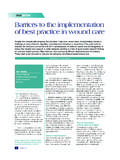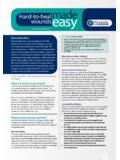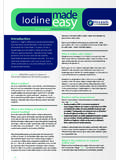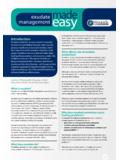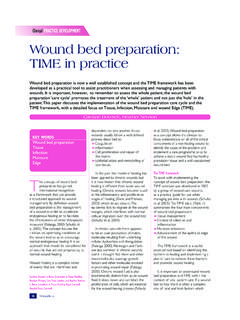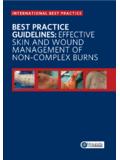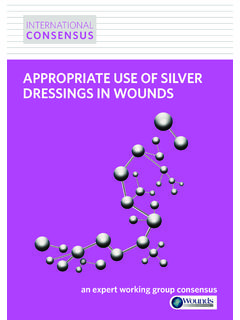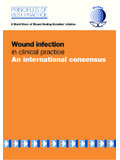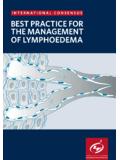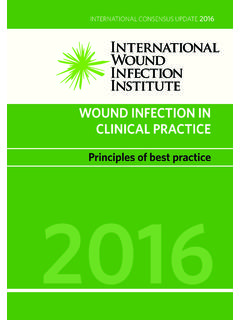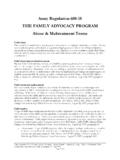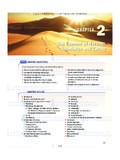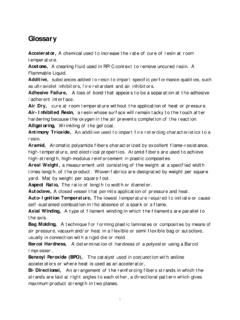Transcription of PRESSURE ULCER PREVENTION pressure, shear, …
1 International R E V I E W. PRESSURE ULCER PREVENTION . PRESSURE , shear, friction and microclimate in context a consensus document KCI Extrinsic 1 07/05/2010 11:41. international R E V I E W. Managing Editor: Lisa MacGregor Expert working group Editor, wounds Mona Baharestani, Wound Care Specialist/Education & Research, James H Quillen Veterans Affairs international: Medical Center, Johnson City, Tennessee, USA; and Clinical Associate Professor, Quillen College of Suzie Calne Medicine, East Tennessee State University, Johnson City, Tennessee, USA. PUBLISHER: Joyce Black, Associate Professor, University of Nebraska Medical Center, College of Nursing, Omaha, Kathy Day Nebraska, USA. PRODUCTION: Keryln Carville, Associate Professor Domiciliary Nursing, Silver Chain Nursing Association & Curtin Alison Pugh University of Technology, Osborne Park, Western Australia PRINTED BY: Michael Clark, Independent Consultant, Cardiff, UK.
2 Printwells, UK. Janet Cuddigan, Associate Professor, Chair, Adult Health and Illness Department, College of Nursing, PUBLISHED BY: University of Nebraska Medical Center, Omaha, Nebraska, USA. Wounds International Enterprise House Carol Dealey, Senior Research Fellow, University Hospitals Birmingham NHS Foundation Trust and 1 2 Hatfields University of Birmingham, Queen Elizabeth Hospital, Birmingham, UK. London SE1 9PG, UK Tom Defloor, Full Professor, Unit Nursing Science, Department of Public Health, Ghent University, Tel: + 44 (0)20 7627 1510 Belgium Fax: +44 (0)20 7627 1570. Amit Gefen, Associate Professor, Department of Biomedical Engineering, The Iby and Aladar Fleischman Faculty of Engineering, Tel Aviv University, Israel Keith Harding, Professor of Rehabilitation Medicine (Wound Healing), Head of Department of Wounds International 2010 Dermatology and Wound Healing, Cardiff University, Cardiff, UK.
3 Nils Lahmann, Associate Professor, Department of Nursing Science, Charit Universit tsmedizin Berlin, Berlin, Germany Maarten Lubbers, Surgeon, Department of Surgery, Academic Medical Center, University of Amsterdam, The Netherlands Supported by an unrestricted Courtney Lyder, Dean and Professor, School of Nursing, Assistant Director for Academic Nursing, educational grant from KCI. Ronald Reagan UCLA Medical Center, University of California, Los Angeles, USA. Takehiko Ohura, Chair, PRESSURE ULCER and Wound Healing Research Center (Kojin-kai), Sapporo, Japan Heather L Orsted, Director - CAWC Institute of Wound Management and PREVENTION and Clinical and Educational Consultant, Canadian Association of Wound Care, Calgary, Alberta, Canada The views expressed are those Vinoth K Ranganathan, Program Manager, Department of Physical Medicine and Rehabilitation, of the authors and do not Cleveland Clinic, Cleveland, Ohio, USA.
4 Necessarily reflect those of KCI. Steven I Reger, Director Emeritus, Rehabilitation Technology, Department of Physical Medicine and Rehabilitation, Cleveland Clinic, Cleveland, Ohio, USA. How to cite this document: International review. PRESSURE Marco Romanelli, Consultant Dermatologist, Wound Research Unit, Department of Dermatology, ULCER PREVENTION : PRESSURE , shear, University of Pisa, Italy friction and microclimate in Hiromi Sanada, Wound, Ostomy and Continence Nurse, Department of Gerontological Nursing/. context. A consensus document. Wound Care Management, Graduate School of Medicine, University of Tokyo, Tokyo, Japan London: Wounds International, 2010. Makoto Takahashi, Associate Professor, Biomedical Systems Engineering, Bioengineering and Bioinformatics, Graduate School of Information Science and Technology, Hokkaido University, Sapporo, Japan Development and consensus process The development of this document involved a process of text review by the expert working group and revision by the authors.
5 It culminated in consensus as indicated by sign off from each working group member and author. KCI Extrinsic 2 07/05/2010 11:41. PRESSURE , shear, friction and microclimate in context HL Orsted, T Ohura, K Harding The overall goal of clinical care is to restore aim of building understanding of the physics or maintain health. Unfortunately, however, involved. This understanding should enable iatrogenic injuries sometimes occur. Although clinicians to better comprehend developments not all PRESSURE ulcers are iatrogenic, most are in the field and, most importantly, will underpin preventable. PRESSURE ulcers are one of the effective and consistent implementation of most frequently reported iatrogenic injuries in PRESSURE ULCER PREVENTION protocols. developed countries. Inappropriate care methods, The three papers PRESSURE in context, Shear such as leaving vulnerable patients in potentially and friction in context, and Microclimate in context damaging positions for long periods of time, or follow a similar structure.
6 They start by massaging reddened areas of skin, often remain defining the relevant extrinsic factors and how in practice long after evidence has shown them to individually they contribute to the aetiology be harmful or ineffective. Education is critical in of PRESSURE ulcers. The relationships between ensuring that all members of a clinical team act the factors are explained and emphasised, and to prevent and treat PRESSURE ulcers according to the evidence for the role of the factors in the the best evidence available. development of PRESSURE ulcers is discussed. The most recent definition of PRESSURE ulcers, The latter sections of the three papers describe which has been produced by an international how patients at risk from each extrinsic factor collaboration of the National PRESSURE ULCER can be identified. The papers then explain Advisory Panel (NPUAP) and the European the types of and rationale for the clinical PRESSURE ULCER Advisory Panel (EPUAP), interventions that aim to prevent or ameliorate highlights current understanding of the role of the adverse effects of each of the extrinsic extrinsic factors in the development of PRESSURE factors discussed.
7 It should be noted that, ulcers1,2 (Box 1). PRESSURE , which is often related although the document covers many major to decreased mobility, has long been viewed as facets of PRESSURE ULCER PREVENTION , discussion the most important extrinsic factor in PRESSURE of comprehensive PREVENTION protocols is ULCER development. However, recent and ongoing beyond its scope. research is revealing that shear, friction and Much research remains to be undertaken to microclimate also have important roles, and that further develop our understanding of the intrinsic there are significant and complex relationships and extrinsic causes of PRESSURE ulcers. But as between all of the extrinsic factors. For example, this document shows, there are some important PRESSURE and shear are closely linked, friction underlying principles for preventing PRESSURE has a role in the development of shear, and ulcers resulting from the extrinsic factors of microclimate influences the susceptibility of skin PRESSURE , shear, friction and microclimate.
8 All and soft tissues to the effects of PRESSURE , shear clinicians should understand these principles and and friction . implement them in their daily practice. The concepts involved in understanding PRESSURE , shear, friction and microclimate and their synergistic actions in the formation of REFERENCEs 1. National PRESSURE ULCER Advisory Panel and European PRESSURE PRESSURE ulcers are complex. Consequently, ULCER Advisory Panel. PREVENTION and treatment of PRESSURE ulcers: the expert working group involved in producing clinical practice guideline. Washington DC: National PRESSURE PRESSURE ULCER PREVENTION : prevalence and incidence ULCER Advisory Panel, 2009. 2. European PRESSURE ULCER Advisory Panel and National in context3 proposed a new document to aid PRESSURE ULCER Advisory Panel. PREVENTION and treatment of understanding of these extrinsic factors. The PRESSURE ulcers: quick reference guide.
9 Washington DC, USA: National PRESSURE ULCER Advisory Panel, 2009. Available expert working group decided that, even though from: and (accessed 23. PRESSURE , shear, friction and microclimate are November 2009). 3. International guidelines. PRESSURE ULCER PREVENTION : prevalence and inextricably inter-related, this new project would incidence in context. A consensus document. London: MEP Ltd, tackle each extrinsic factor individually with the 2009. BOX 1 New NPUAP/EPUAP definition of PRESSURE ulcers1. "A PRESSURE ULCER is localized injury to the skin and/or underlying tissue, usually over a bony prominence, as a result of PRESSURE , or PRESSURE in combination with shear. A number of contributing or confounding factors are also associated with PRESSURE ulcers; the significance of these factors has yet to be elucidated.". PRESSURE , SHEAR, friction AND MICROCLIMATE IN CONTEXT | 1. KCI Extrinsic 3 07/05/2010 11:41.
10 PRESSURE in context M Takahashi, J Black, C Dealey, A Gefen Introduction What types of internal stresses does PRESSURE PRESSURE has been recognised as the most cause? important extrinsic factor involved in the When PRESSURE is applied to skin, particularly development of PRESSURE ulcers for many over a bony prominence, it distorts the skin and years. Consequently, it features prominently in underlying soft tissues. In the model in Figure 3, definitions of PRESSURE ulcers, including the recent the horizontal lines immediately under the bony definition produced by the National PRESSURE prominence become closer together indicating ULCER Advisory Panel (NPUAP) and European tissue compression. In other places, particularly PRESSURE ULCER Advisory Panel (EPUAP)1,2. under the bony prominence, the lines are also This paper explains what PRESSURE is, how elongated, indicating tensile (stretching) and PRESSURE contributes to PRESSURE ULCER formation shear (distorting) stresses.
